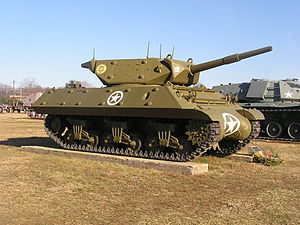M10 tank destroyer
| 3-inch Gun Motor Carriage M10 | |
|---|---|
 |
|
| Type | Tank destroyer |
| Place of origin | United States |
| Production history | |
| Designer | U.S. Army Ordnance Department |
| Designed | 1942 |
| Manufacturer |
Fisher Body division of General Motors Ford Motor Company |
| Unit cost | $47,900 |
| Produced | September 1942–December 1943 |
| No. built | 6,406 |
| Variants | see Variants |
| Specifications (3-inch Gun Motor Carriage M10/M10A1) | |
| Weight | M10: 65,200 lb (29.57 metric tons) M10A1: 64,000 lb (29.03 metric tons) |
| Length | 19 ft 7 in (5.97 m) hull 22 ft 5 in (6.83 m) including gun |
| Width | 10 ft 0 in (3.05 m) |
| Height | 9 ft 6 in (2.89 m) over antiaircraft machine gun |
| Crew | 5 (Commander, gunner, loader, driver, assistant driver) |
|
|
|
| Armor | 0.375 to 2.25 in (9.5 to 57.2 mm) |
|
Main
armament |
3-inch Gun M7 in Mount M5 54 rounds |
|
Secondary
armament |
.50 caliber (12.7 mm) Browning M2HB machine gun 300 rounds |
| Engine | M10: General Motors 6046 twin diesel; 375 hp (280 kW) at 2,100 rpm M10A1: Ford GAA V8; 450 hp (336 kW) at 2,600 rpm |
| Power/weight | M10: 12.68 hp/metric ton M10A1: 15.50 hp/metric ton |
| Transmission |
Synchromesh 5 speeds forward, 1 reverse |
| Suspension | Vertical volute spring suspension (VVSS) |
| Fuel capacity | M10: 165 US gallons (625 litres) M10A1: 192 US gallons (727 litres) |
|
Operational
range |
M10: 200 mi (300 km) M10A1: 160 mi (260 km) |
| Speed | M10: 25-30 mph (40-51 km/h) on road M10A1: 30 mph (51 km/h) on road |
The M10 tank destroyer was an American tank destroyer of World War II. After US entry into World War II and the formation of the Tank Destroyer Force, a suitable vehicle was needed to equip the new battalions. By November 1941, the Army requested a vehicle with a gun in a fully rotating turret after other interim models were criticized for being too poorly designed. The prototype of the M10 was conceived in early 1942, being delivered in April of that year. After appropriate changes to the hull and turret were made, the modified version was selected for production in June 1943 as the 3-inch Gun Motor Carriage M10. It mounted a 3-inch (76.2 mm) Gun M7 in a rotating turret on a modified M4A2 Sherman tank chassis. An alternate model, the M10A1, which used the chassis of an M4A3 Sherman tank, was also produced. Production of the two models ran from September 1942 to December 1943 and October 1942 to November 1943, respectively.
The first vehicle to establish the American style of World War II tank destroyer, the M10 was numerically the most important U.S. tank destroyer of World War II. It combined thin but sloped armor with the M4 Sherman's reliable hull and drivetrain, and a reasonably potent anti-tank weapon mounted in an open-topped turret. Despite its obsolescence in the face of more powerful German tanks like the Panther and the introduction of more powerful and better-designed types as replacements, the M10 remained in service until the end of the war. During World War II, the primary user of the M10 tank destroyer was the United States, but many were Lend-Leased to the United Kingdom and Free French forces for distribution to their respective allies. Several dozen were also sent to the Soviet Union. Post-war, the M10 was given as military surplus to several countries, such as Belgium, Denmark, and the Netherlands, through the Mutual Defense Assistance Act or acquired through other means by countries like Israel and the Republic of China.
...
Wikipedia
